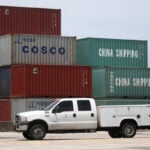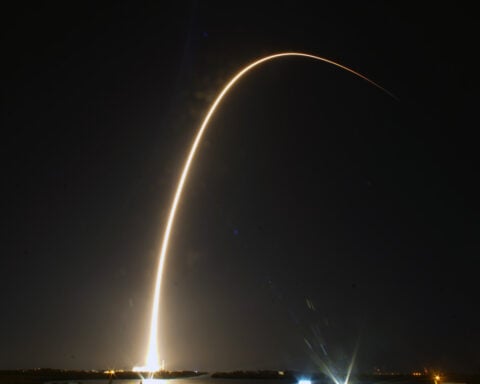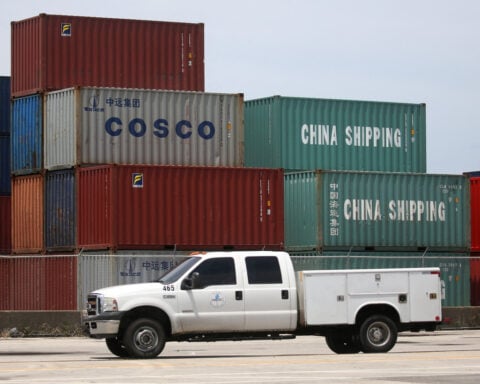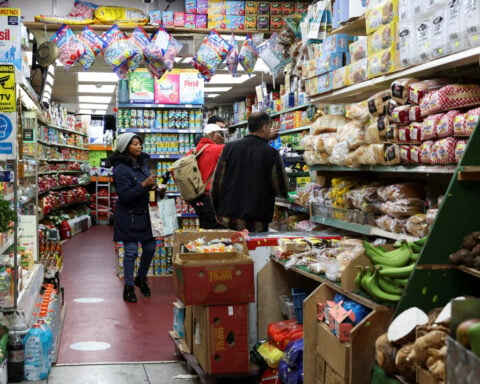By Karl Plume
(Reuters) - Bulk grain shippers hauling crops from the U.S. Gulf Coast export hub to Asia are sailing longer routes and paying higher freight costs to avoid vessel congestion and record-high transit fees in the drought-hit Panama Canal, traders and analysts said.
The shipping snarl through one of the world's main maritime trade routes comes at the peak season for U.S. crop exports, and the higher costs are threatening to dent demand for U.S. corn and soy suppliers that have already ceded market share to Brazil in recent years.
Ships moving crops have faced wait times of up to three weeks to pass through the canal as container vessels and others that sail on more regular schedules are scooping up the few transit slots available.
The restrictions could continue to impede grain shipments well into 2024 when the region's wet season may begin to recharge reservoirs and normalize shipping in April or May, analysts said.
"It's causing quite a disruption both in expense and delay," said Jay O'Neil, proprietor of HJ O'Neil Commodity Consulting, adding that the disruption is unlike any he's seen in his 50 years of monitoring global shipping.
The Panama Canal Authority restricted vessel transits this autumn as a severe drought limited supplies of water needed to operate its lock system. The Authority did not respond to request for comment on grain shipment delays.
Only 22 daily transits are currently allowed, down from around 35 in normal conditions. By February, transits will shrink further to 18 a day.
Grain ships are often at the back of the line as they usually seek transit slots only a few days before arriving, while others like cruise and container ships book months in advance.
The Authority also offers the rare available slots to its top customers first, none of which are bulk grain haulers, O'Neil said.
Any scheduled slots that come available are auctioned off, but demand is exceptionally high. Some slots have gone for $1 million or more, untenable costs for the traditionally thin-margin grain trading business.
"The grain trades and the bulk carrier segment are going to be the last customers to go through the Panama Canal. I would not rely on the Panama Canal any time soon," said Mark Thompson, senior trader at Olam Agri.
Wait times for bulk grain vessels ballooned from around five to seven days in October to around 20 days by late November, O'Neil said, prompting more grain carriers to reroute.
Options include sailing south around South America or Africa, or transiting the Suez Canal. But those longer routes can add up to two weeks to shipping times, elevating costs for fuel, crews and freight leases.
The benchmark Baltic Dry Index, considered a benchmark for bulk grain freight, spiked to a 1-1/2 year peak on Dec. 4, more than doubling from a month earlier.
While grain prices have fallen from 2020 peaks, higher freight costs will be passed on to grain and oilseed importers who buy for human food and livestock feed.
"Commercial companies have been finding ways to navigate around the problem. But undoubtedly it costs the end-user more money," said Dan Basse, president of Chicago-based consultancy AgResource Co.
In the second half of October, only five U.S. Gulf grain vessels bound for east Asia transited the Panama Canal, while 33 sailed east to use the Suez Canal instead, according to a U.S. Department of Agriculture (USDA) report. In the same period last year, 34 vessels used the Panama Canal while only seven used the Suez.
Some U.S. exporters have also been rerouting crop shipments to Asia to load from Pacific Northwest ports instead.
But that, too, comes at a higher cost as those facilities source grain mostly via rail as opposed to the cheaper barge-delivered loads supplying Gulf Coast exporters.
Only 56.8% of all U.S. corn exports in October were shipped from Gulf Coast ports this year, down from 64.9% in October 2022 and 72.1% in October 2021, according to USDA weekly export inspections data.
(Reporting by Karl Plume in Chicago, additional reporting by Gus Trompiz in Paris; Editing by Josie Kao)

 India's navy launches submarine, warships to guard against China's presence in Indian Ocean
India's navy launches submarine, warships to guard against China's presence in Indian Ocean
 UK inflation unexpectedly eases in December, which could reduce pressure in bond markets
UK inflation unexpectedly eases in December, which could reduce pressure in bond markets
 Body count from South African mine siege rises to 60
Body count from South African mine siege rises to 60
 Question on ASEAN stumped Hegseth at Senate hearing. What is it and why is it important?
Question on ASEAN stumped Hegseth at Senate hearing. What is it and why is it important?
 US importers rush in goods from China as Trump tariff threat looms
US importers rush in goods from China as Trump tariff threat looms
 Novak Djokovic breaks a tie with Roger Federer for the most Grand Slam matches in tennis history
Novak Djokovic breaks a tie with Roger Federer for the most Grand Slam matches in tennis history
 China's RedNote: what you need to know about the app TikTok users are flocking to
China's RedNote: what you need to know about the app TikTok users are flocking to
 British author Neil Gaiman denies ever engaging in non-consensual sex as more accusers come forward
British author Neil Gaiman denies ever engaging in non-consensual sex as more accusers come forward








